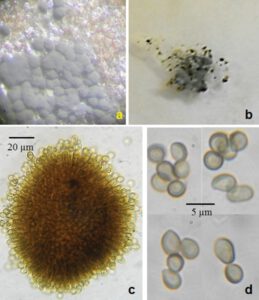Pseudoepicoccum cocos (F. Stevens) M.B. Ellis, Dematiaceous Hyphomycetes: 270 (1971)
Basionym: Epicoccum cocos F. Stevens, Philipp. Agric. 21: 81 (1932)
Colonies on leaf spots brown, with circular zones, with blackened elevated centres and yellow margins, up to 1 cm diam. Stromata superficial, hemispherical, brown, pseudoparenchymatous. Sexual state: Unknown. Asexual state: Sporodochia 90–110 × 50–75 µm, punctiform, dark brown. Conidiophores 13–18 × 3–4 µm, macronematous, mononematous, straight or slightly flexuous, septate, unbranched, pale brown, smooth-walled. Conidiogenous cells 3–5 × 3–4 µm, integrated, terminal, sympodial, cicatrized. Conidia 3–5.5 × 2.5–3 µm, solitary, dry, aseptate, simple, acropleurogenous, subspherical, pale brown, minutely verrucose. Colonies on MEA dark green, irregular, powdery, attaining 0.8 cm diam. in 7 days; reverse dark green to black.
Specimen examined – India. Goa: Canacona, Mashem, on living leaves of Cocos nucifera, 19 October 2012, A. Prabhugaonkar (MTCC 11762!). Philippines. Entomological Exp. Field, Laguna, on leaves of Cocos nucifera, 29 Jul 1930, F.L. Stevens (MICH15584, isotype)
Notes — We observed the type specimen of Epicoccum cocos, which proved to be identical to our specimen.

Figure 1 – Pseudoepicoccum cocos. a. Colonies on leaf spots. b. Culture on MEA. c. Sporodochia. d. Conidia
